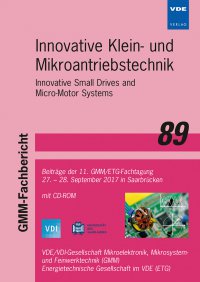Analysis of the Influence of Static and Dynamic Eccentricity on Back EMF of a Permanent Magnet Synchronous Motor
Conference: Innovative Klein- und Mikroantriebstechnik - 11. GMM/ETG-Fachtagung
09/27/2017 - 09/28/2017 at Saarbrücken, Deutschland
Proceedings: Innovative Klein- und Mikroantriebstechnik
Pages: 6Language: englishTyp: PDF
Personal VDE Members are entitled to a 10% discount on this title
Authors:
Fischer, M.; Roth-Stielow, J. (University of Stuttgart, Institute for Power Electronics and Electrical Drives, 70569 Stuttgart, Germany)
Abstract:
In this paper the measurement results that represent the back electromotive force (EMF) of a small drive permanent magnet synchronous machine (PMSM) are proposed. The focus is on the comparison between three mechanical configurations: the original one and a setup with static and dynamic eccentricity. Additionally, the influence of compensating currents is considered due to the circuitry of the windings belonging to one phase. This leads to quite similar gradients of back EMF in all three mechanical configurations. The PMSM consists of an external rotor, has a pole pair number of 4 and a mechanical output power of 240 W. Each electric phase consists of four windings. Two of them are serial connected and both serial connections are parallel connected. If the partial back EMF at one winding is not equal to the back EMF at windings of the same phase, compensating currents will occur and will counteract the partial back EMF. This happens especially in case of static and dynamic eccentricity. In these cases the air gap length as well as the partial back EMF depend besides on the position also on the angle between the rotor and the stator of the machine. To analyse the back EMF at several operating points, a machine test bench is set up. In order to measure the partial back EMF, the machine is equipped with additional stator windings. Furthermore, the parallel connections of the windings are disconnected and the pins are led through the machine’s package. On the one hand, it is possible to leave the connection open-circuited to avoid compensating currents. On the other hand, the connection can be restored using an amperemeter, which enables a measurement of the intensity of the compensating currents at different operating points. Due to mechanical modifications on the machine it is possible to analyse the specific influence of static and dynamic eccentricity.


